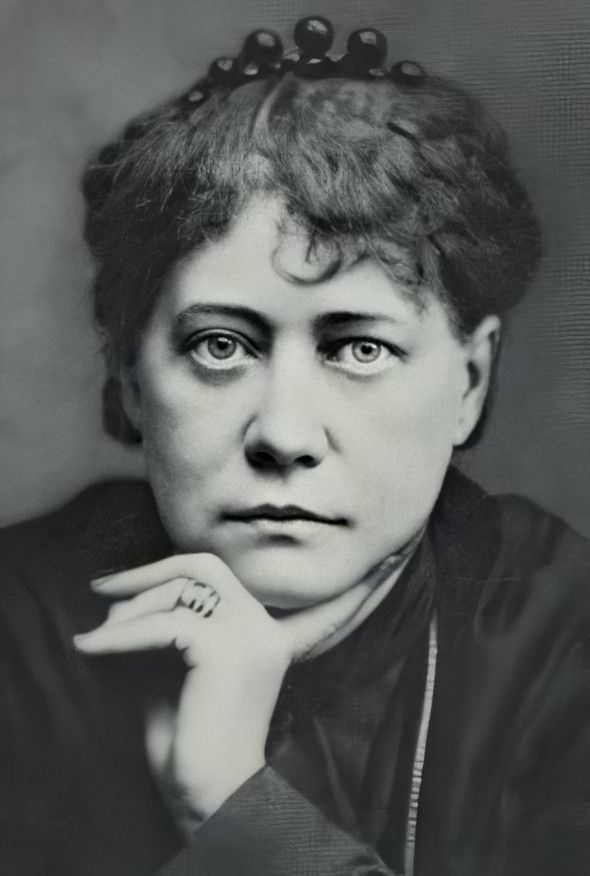
Helena Petrovna Blavatsky, often known as Madame Blavatsky, was a Russian and American mystic and author who co-founded the Theosophical Society in 1875. She gained an international following as the primary founder of Theosophy as a belief system.
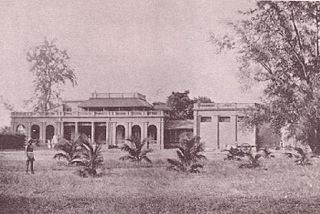
The Theosophy Society was founded by Helena Petrovna Blavatsky and others in 1875. The designation 'Adyar' is sometimes added to the name to make it clear that this is the Theosophical Society headquartered there, after the American section and some other lodges separated from it in 1895, under William Quan Judge. In 1882, its headquarters moved with Blavatsky and president Henry Steel Olcott from New York to Adyar, an area of Chennai, India.
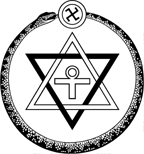
The Theosophical Society is the organizational body of Theosophy, an esoteric new religious movement. It was founded in New York City, U.S. in 1875. Among its founders were Helena Blavatsky, a Russian mystic and the principal thinker of the Theosophy movement, and Henry Steel Olcott, the society's first president. It draws upon a wide array of influences among them older European philosophies and movements such as Neoplatonism and occultism, as well as parts of Asian religious traditions such as Hinduism, Buddhism, and Islam.

Annie Besant was a British socialist, theosophist, freemason, women's rights and Home Rule activist, educationist and campaigner for Indian nationalism. She was an ardent supporter of both Irish and Indian self-rule. She became the first female president of the Indian National Congress in 1917.

Charles Webster Leadbeater was a member of the Theosophical Society, Co-Freemasonry, an author on occult subjects, and the co-initiator, with J. I. Wedgwood, of the Liberal Catholic Church.
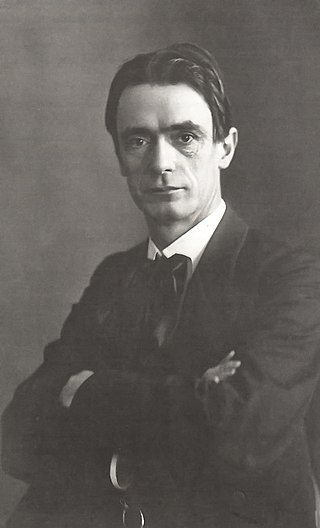
In the religion of Theosophy and the spiritual movement called Anthroposophy, the Akashic records are believed by Theosophists to be a compendium of all universal events, thoughts, words, emotions, and intent ever to have occurred in the past, present, or future in terms of all entities and life forms, not just human. They are believed by theosophists to be encoded in a non-physical plane of existence known as the mental plane. There is no evidence for the existence of Akashic records, and rigorous scientific research in this field has seen little traction.

Alice Ann Bailey was author of about 25 books on Theosophy and among the first writers to use the term New Age. She was born Alice La Trobe-Bateman, in Manchester, England and moved to the United States in 1907, where she spent most of her life as a writer and teacher.

The Theosophical Society in America (TSA) is a member-based nonprofit organization dedicated to the teaching of Theosophy and affiliated with the international Theosophical Society based in Adyar, Chennai, India. The name "Theosophical Society in America" was legally adopted by the American Theosophical Society in 1934. Previously, other organizations had used the same name during the years 1895–98 and 1898–1908.

Morya, also spelt Maurya, is one of the "Masters of the Ancient Wisdom" within modern Theosophical beliefs. He is believed by followers of Theosophism to be one of the Mahatmas who inspired the founding of the Theosophical Society and was engaged in a correspondence with two English Theosophists living in India, A. P. Sinnett and A. O. Hume. The correspondence was published in 1923 by A. Trevor Barker in the book The Mahatma Letters to A. P. Sinnett.

The Theosophist is the monthly journal of the international Theosophical Society based in Adyar, India. It was founded in India in 1879 by Helena Blavatsky, who was also its editor. The journal is still being published till date. For the year 1930, the journal was published in Hollywood, California by Annie Besant and Marie Russak Hotchener, but it returned to Adyar in 1931. The journal features articles about philosophy, art, literature and occultism.

Theosophical teachings have borrowed some concepts and terms from Buddhism. Some theosophists like Helena Blavatsky, Helena Roerich and Henry Steel Olcott also became Buddhists. Henry Steel Olcott helped shape the design of the Buddhist flag. Tibetan Buddhism was popularised in the West at first mainly by Theosophists including Evans-Wentz and Alexandra David-Neel.

Neo-Theosophy is a term, originally derogatory, used by the followers of Helena Blavatsky to denominate the system of Theosophical ideas expounded by Annie Besant and Charles Webster Leadbeater following the death of Madame Blavatsky in 1891. This material differed in major respects from Blavatsky's original presentation, but it is accepted as genuinely Theosophical by many Theosophists around the world.
The Order of the Star in the East (OSE) was an international organization based at Benares (Varanasi), India from 1911 to 1927. It was established by the leadership of the Theosophical Society at Adyar, Madras (Chennai) to prepare the world for the arrival of a reputed messianic entity, the World Teacher or Maitreya. The OSE acquired members worldwide as it expanded in many countries; a third of its diverse membership c. 1926 was unaffiliated with the Theosophical Society. The precursor of the OSE was the Order of the Rising Sun and the successor was the Order of the Star. The precursor organization was formed after leading Theosophists discovered a likely candidate for the new messiah in the then–adolescent Jiddu Krishnamurti (1895–1986), a South Indian Brahmin who was installed as Head of the Order. Almost two decades later Krishnamurti rejected the messianic role, repudiated the Order's mission and in 1929 disbanded the OSE's successor. The founding and activities of these organizations as well as the largely unexpected dissolution of the OSE's successor, attracted widespread media attention and public interest. They also led to crises in the Theosophical Society and to schisms in Theosophy. Krishnamurti's later multi-decade career as a notable independent philosopher has been a factor in evaluations of the OSE and its mission.

In Theosophy, Maitreya or Lord Maitreya is an advanced spiritual entity and high-ranking member of a reputed hidden spiritual hierarchy, the Masters of the Ancient Wisdom. According to Theosophical doctrine, one of the hierarchy's functions is to oversee the evolution of humankind; in concert with this function, Maitreya is said to hold the "Office of the World Teacher". Theosophical texts posit that the purpose of this Office is to facilitate the transfer of knowledge about the true constitution and workings of Existence to humankind. Humanity is thereby assisted on its presumed cyclical but ever-progressive evolutionary path. Reputedly, one way the knowledge transfer is accomplished is by Maitreya occasionally manifesting or incarnating in the physical realm; the manifested entity then assumes the role of World Teacher of Humankind.

Man: Whence, How and Whither, A Record of Clairvoyant Investigation, published in 1913, is a theosophical book compiled by the second president of the Theosophical Society (TS) - Adyar, Annie Besant, and by a TS member, Charles W. Leadbeater. The book is a study on early times on planetary chains, beginnings of early root races, early civilizations and empires, and past lives of men.

Theosophy is a religious and philosophical system established in the United States in the late 19th century. Founded primarily by the Russian Helena Blavatsky, and based largely on her writings, it draws heavily from both older European philosophies such as Neoplatonism and Indian religions such as Hinduism and Buddhism. Although many adherents maintain that Theosophy is not a religion, it is variably categorized by religious scholars as both a new religious movement and a form of occultism from within Western esotericism.
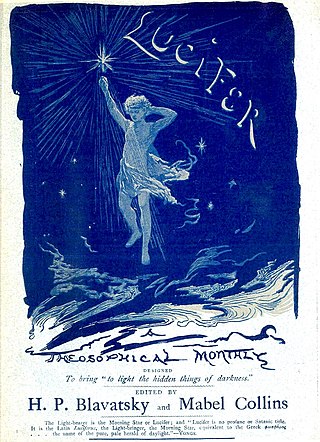
"The Esoteric Character of the Gospels" is an article published in three parts: in November-December 1887, and in February 1888, in the theosophical magazine Lucifer; it was written by Helena Blavatsky. It was included in the 8th volume of the author's Collected Writings. In 1888, for this work, the author was awarded Subba Row medal.

Modern Theosophy is classified by prominent representatives of Western philosophy as a "pantheistic philosophical-religious system." Russian philosopher Vladimir Trefilov claimed that Blavatsky's doctrine was formed from the beginning as a synthesis of philosophical views and religious forms of the various ages and peoples with modern scientific ideas. Michael Wakoff, an author of The Routledge Encyclopedia of Philosophy, stated that Blavatskian Theosophy was based on Buddhist and Hindu philosophy, and fragments of the Western esotericism with using an "absolutist metaphysics." In The New Encyclopedia of Philosophy it is said that Blavatsky's Theosophy is an attempt to merge into a universal doctrine all religions by revealing their "common deep essence" and detection of "identity meanings of symbols," all philosophies, and all sciences.

"What Is Theosophy?" is an editorial published in October 1879 in the Theosophical magazine The Theosophist. It was compiled by Helena Blavatsky and included into the 2nd volume of the Blavatsky Collected Writings. According to a doctoral thesis by Tim Rudbøg, in this "important" article Blavatsky "began conceptualizing her idea of 'Theosophy'."
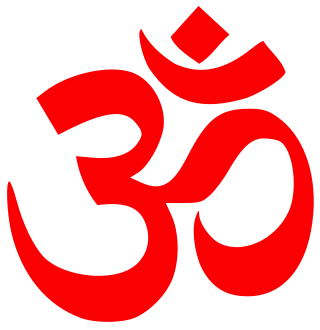
Hinduism is regarded by modern Theosophy as one of the main sources of "esoteric wisdom" of the East. The Theosophical Society was created in a hope that Asian philosophical-religious ideas "could be integrated into a grand religious synthesis." Prof. Antoine Faivre wrote that "by its content and its inspiration" the Theosophical Society is greatly dependent on Eastern traditions, "especially Hindu; in this, it well reflects the cultural climate in which it was born." A Russian Indologist Alexander Senkevich noted that the concept of Helena Blavatsky's Theosophy was based on Hinduism. According to Encyclopedia of Hinduism, "Theosophy is basically a Western esoteric teaching, but it resonated with Hinduism at a variety of points."

















